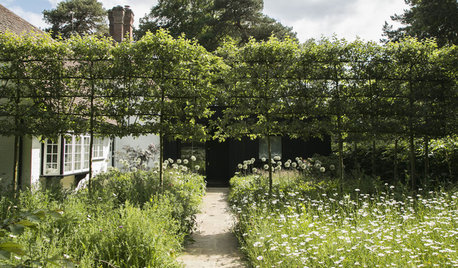New Home, 72 apple trees, and need advice, please!
greenhousekendra
14 years ago
Related Stories

EDIBLE GARDENSHow to Add an Apple Tree to Your Edible Garden
Readily available, beautiful and fragrant, apple trees offer four-season interest along with crisp, juicy fruit
Full Story
BATHROOM DESIGNDreaming of a Spa Tub at Home? Read This Pro Advice First
Before you float away on visions of jets and bubbles and the steamiest water around, consider these very real spa tub issues
Full Story
GARDENING AND LANDSCAPINGCrab Apple Trees Set Off a Stylish English Courtyard
A structure of pleached crab apple trees, bordered by a wildflower meadow, links a minimalist addition to an old house in Buckinghamshire
Full Story
HEALTHY HOMEHow to Childproof Your Home: Expert Advice
Safety strategies, Part 1: Get the lowdown from the pros on which areas of the home need locks, lids, gates and more
Full Story
HOUSEPLANTSMother-in-Law's Tongue: Surprisingly Easy to Please
This low-maintenance, high-impact houseplant fits in with any design and can clear the air, too
Full Story
DECORATING GUIDES10 Design Tips Learned From the Worst Advice Ever
If these Houzzers’ tales don’t bolster the courage of your design convictions, nothing will
Full Story
DECORATING GUIDESDecorating Advice to Steal From Your Suit
Create a look of confidence that’s tailor made to fit your style by following these 7 key tips
Full Story
FARM YOUR YARDAdvice on Canyon Farming From L.A.'s Vegetable Whisperer
See how a screened garden house and raised beds help an edible garden in a Los Angeles canyon thrive
Full Story
HOME OFFICESQuiet, Please! How to Cut Noise Pollution at Home
Leaf blowers, trucks or noisy neighbors driving you berserk? These sound-reduction strategies can help you hush things up
Full Story
SUMMER GARDENINGHouzz Call: Please Show Us Your Summer Garden!
Share pictures of your home and yard this summer — we’d love to feature them in an upcoming story
Full Story







eskota
alan haigh
Related Professionals
Norton Shores Landscape Architects & Landscape Designers · Manchester Landscape Contractors · Bloomington Landscape Contractors · Choctaw Landscape Contractors · Ellicott City Landscape Contractors · Longmont Landscape Contractors · Mastic Beach Landscape Contractors · Oklahoma City Landscape Contractors · Pacifica Landscape Contractors · Richmond Landscape Contractors · Vashon Landscape Contractors · Markham Landscape Contractors · Tyngsboro Landscape Contractors · Maple Heights Landscape Contractors · Gulf Gate Estates Tree Servicesolpea
Axel
glenn_russell
eric_wa
applenut_gw
alan haigh
olpea
Axel
eric_wa
Axel
Michael
greenhousekendraOriginal Author
alan haigh
glib
glenn_russell
Axel
Axel
john_in_sc
glenn_russell
alan haigh
Axel
greenhousekendraOriginal Author
Axel
Scott F Smith
alan haigh
alan haigh
myk1
Michael
alan haigh
john_in_sc
myk1
olpea
thisisme
greenhousekendraOriginal Author
eskota
Axel
eskota
greenhousekendraOriginal Author
myk1
thisisme
alan haigh
Axel
glib
franktank232
kansasapple
alan haigh
glenn_russell
greenhousekendraOriginal Author